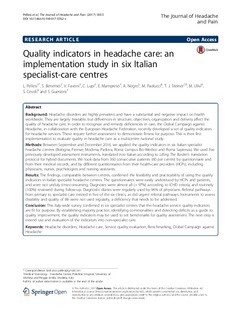| dc.contributor.author | Pellesi, L | |
| dc.contributor.author | Benemei, S | |
| dc.contributor.author | Favoni, V | |
| dc.contributor.author | Lupi, C | |
| dc.contributor.author | Mampreso, E | |
| dc.contributor.author | Negro, A | |
| dc.contributor.author | Paolucci, M | |
| dc.contributor.author | Steiner, Timothy J. | |
| dc.contributor.author | Ulivi, M | |
| dc.contributor.author | Cevoli, S | |
| dc.contributor.author | Guerzoni, S | |
| dc.date.accessioned | 2018-07-27T12:42:50Z | |
| dc.date.available | 2018-07-27T12:42:50Z | |
| dc.date.created | 2018-01-04T16:53:16Z | |
| dc.date.issued | 2017 | |
| dc.identifier.citation | The Journal of Headache and Pain. 2017, 18 (1). | nb_NO |
| dc.identifier.issn | 1129-2369 | |
| dc.identifier.uri | http://hdl.handle.net/11250/2506688 | |
| dc.description.abstract | Background: Headache disorders are highly prevalent, and have a substantial and negative impact on health worldwide. They are largely treatable, but differences in structure, objectives, organization and delivery affect the quality of headache care. In order to recognize and remedy deficiencies in care, the Global Campaign against Headache, in collaboration with the European Headache Federation, recently developed a set of quality indicators for headache services. These require further assessment to demonstrate fitness for purpose. This is their first implementation to evaluate quality in headache care as a multicentre national study. Methods: Between September and December 2016, we applied the quality indicators in six Italian specialist headache centres (Bologna, Firenze, Modena, Padova, Roma Campus Bio-Medico and Roma Sapienza). We used five previously developed assessment instruments, translated into Italian according to Lifting The Burden’s translation protocol for hybrid documents. We took data from 360 consecutive patients (60 per centre) by questionnaire and from their medical records, and by different questionnaires from their health-care providers (HCPs), including physicians, nurses, psychologists and nursing assistants. Results: The findings, comparable between centres, confirmed the feasibility and practicability of using the quality indicators in Italian specialist headache centres. The questionnaires were easily understood by HCPs and patients, and were not unduly time-consuming. Diagnoses were almost all (> 97%) according to ICHD criteria, and routinely (100%) reviewed during follow-up. Diagnostic diaries were regularly used by 96% of physicians. Referral pathways from primary to specialist care existed in five of the six clinics, as did urgent referral pathways. Instruments to assess disability and quality of life were not used regularly, a deficiency that needs to be addressed. Conclusion: This Italy-wide survey confirmed in six specialist centres that the headache service quality indicators are fit for purpose. By establishing majority practice, identifying commonalities and detecting deficits as a guide to quality improvement, the quality indicators may be used to set benchmarks for quality assessment. The next step is extend use and evaluation of the indicators into non-specialist care. | nb_NO |
| dc.language.iso | eng | nb_NO |
| dc.publisher | Springer Nature | nb_NO |
| dc.rights | Navngivelse 4.0 Internasjonal | * |
| dc.rights.uri | http://creativecommons.org/licenses/by/4.0/deed.no | * |
| dc.title | Quality indicators in headache care: an implementation study in six Italian specialist-care centres | nb_NO |
| dc.title.alternative | Quality indicators in headache care: an implementation study in six Italian specialist-care centres | nb_NO |
| dc.type | Journal article | nb_NO |
| dc.type | Peer reviewed | nb_NO |
| dc.description.version | publishedVersion | nb_NO |
| dc.source.pagenumber | 9 | nb_NO |
| dc.source.volume | 18 | nb_NO |
| dc.source.journal | The Journal of Headache and Pain | nb_NO |
| dc.source.issue | 1 | nb_NO |
| dc.identifier.doi | 10.1186/s10194-017-0762-x | |
| dc.identifier.cristin | 1536174 | |
| dc.description.localcode | © The Author(s). 2017 Open Access This article is distributed under the terms of the Creative Commons Attribution 4.0 International License (http://creativecommons.org/licenses/by/4.0/), which permits unrestricted use, distribution, and reproduction in any medium, provided you give appropriate credit to the original author(s) and the source, provide a link to the Creative Commons license, and indicate if changes were made. | nb_NO |
| cristin.unitcode | 194,65,30,0 | |
| cristin.unitname | Institutt for nevromedisin og bevegelsesvitenskap | |
| cristin.ispublished | true | |
| cristin.fulltext | original | |
| cristin.qualitycode | 1 | |

